HR: Evaluating the Organizational Context of Scientific Management
VerifiedAdded on 2023/01/03
|10
|3082
|78
Report
AI Summary
This report delves into the organizational context of Human Resources (HR), focusing on the principles of scientific management. It begins by introducing the core concepts of HR management, emphasizing its role in enhancing employee performance, and achieving organizational goals. The report the...
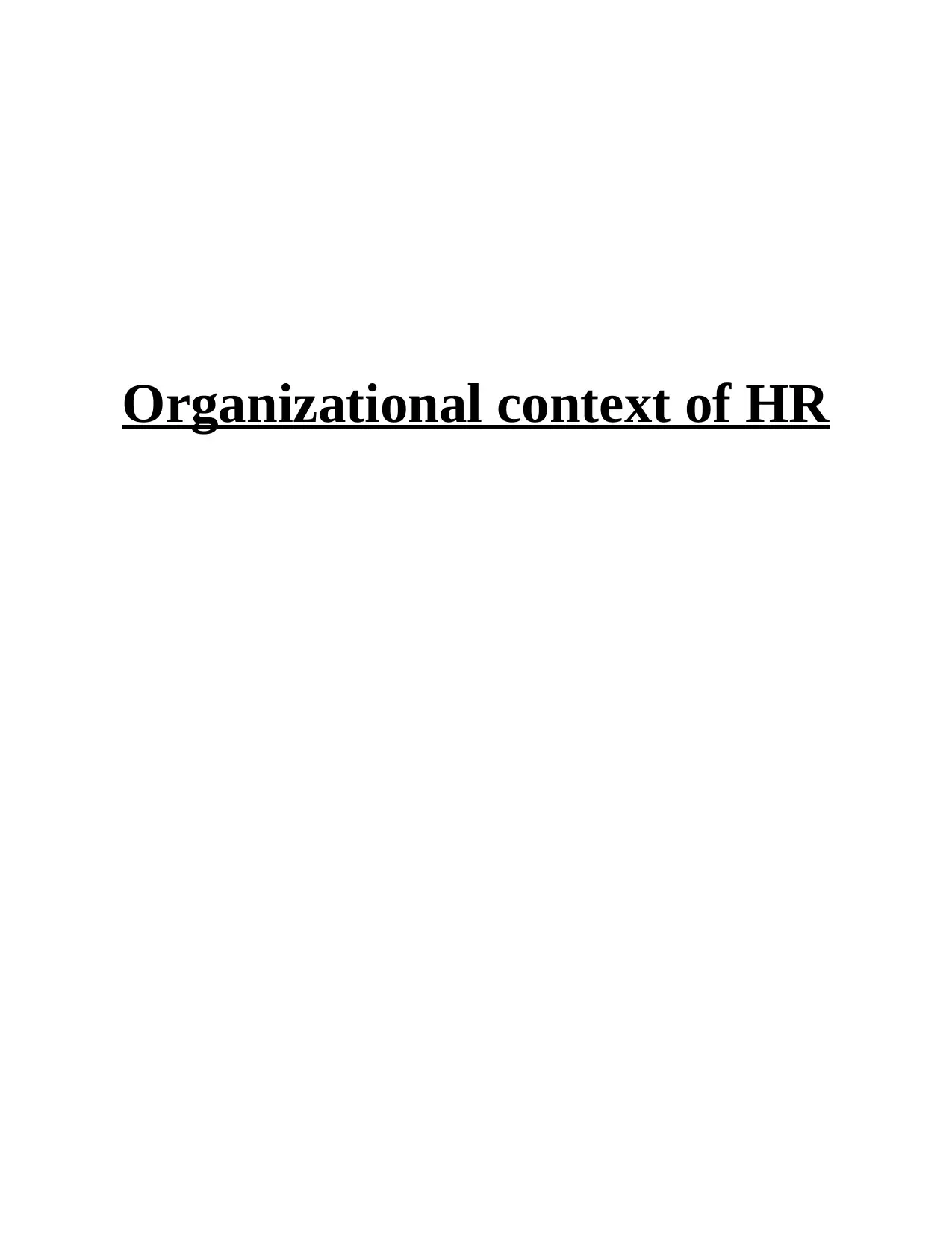
Organizational context of HR
Paraphrase This Document
Need a fresh take? Get an instant paraphrase of this document with our AI Paraphraser
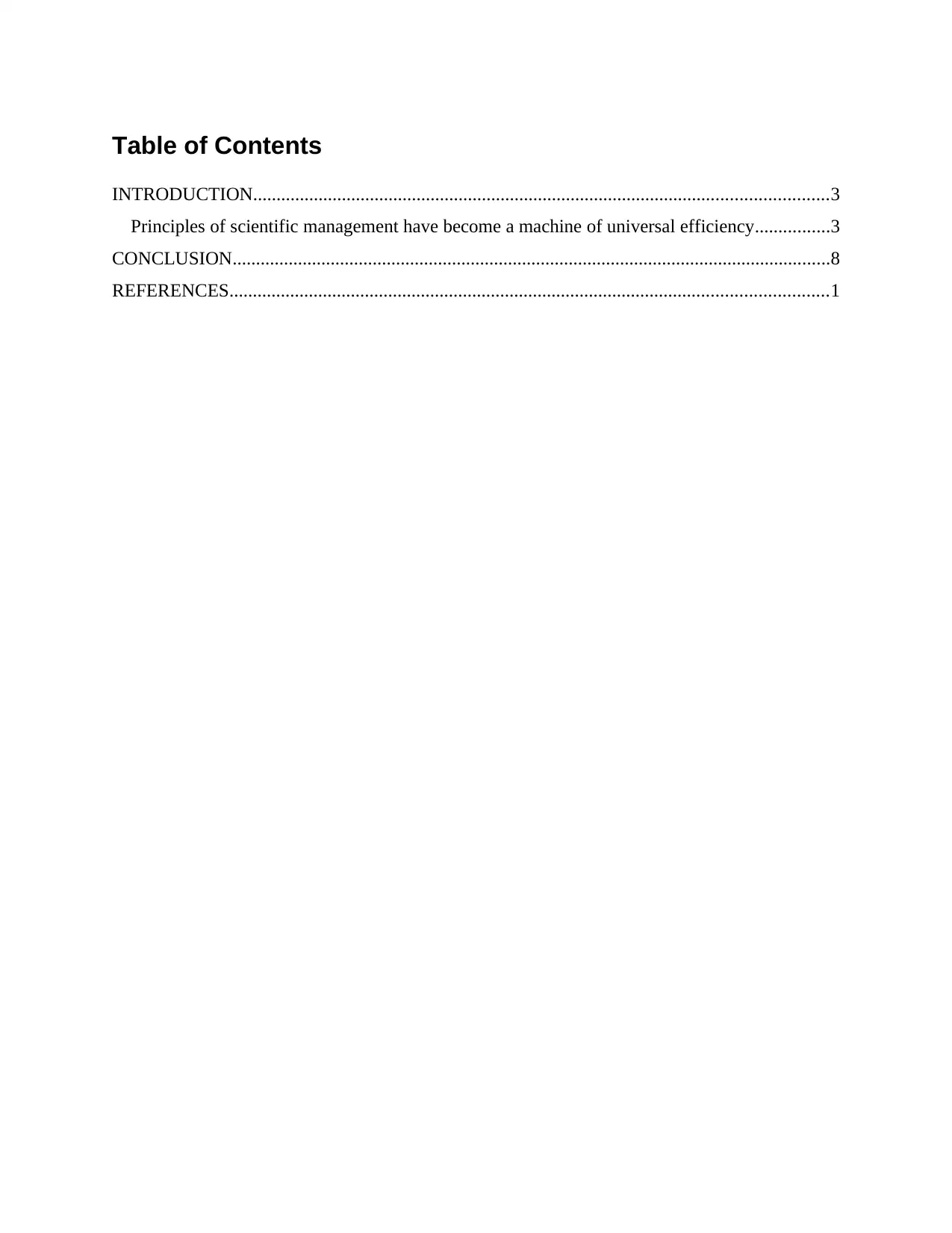
Table of Contents
INTRODUCTION...........................................................................................................................3
Principles of scientific management have become a machine of universal efficiency................3
CONCLUSION................................................................................................................................8
REFERENCES................................................................................................................................1
INTRODUCTION...........................................................................................................................3
Principles of scientific management have become a machine of universal efficiency................3
CONCLUSION................................................................................................................................8
REFERENCES................................................................................................................................1
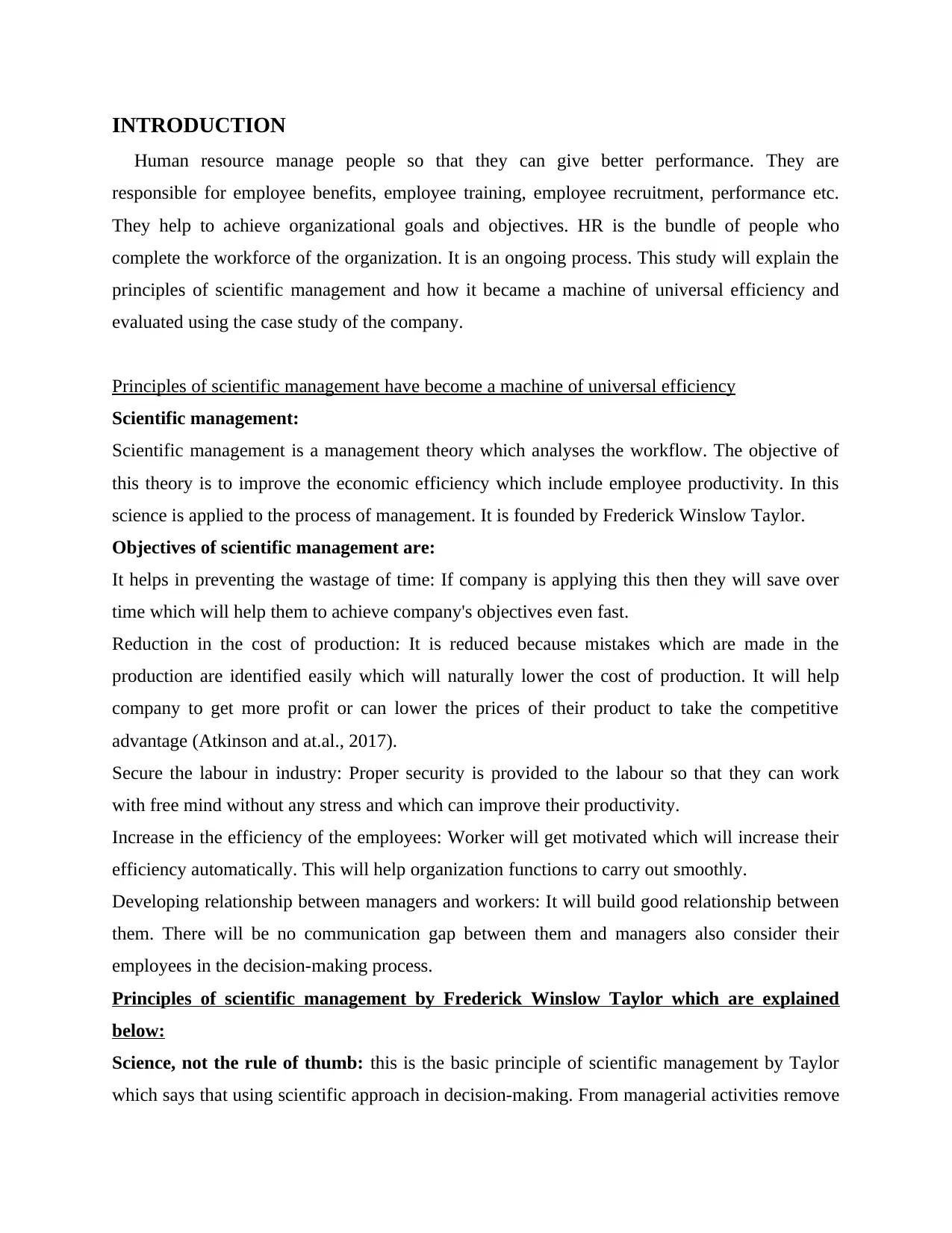
INTRODUCTION
Human resource manage people so that they can give better performance. They are
responsible for employee benefits, employee training, employee recruitment, performance etc.
They help to achieve organizational goals and objectives. HR is the bundle of people who
complete the workforce of the organization. It is an ongoing process. This study will explain the
principles of scientific management and how it became a machine of universal efficiency and
evaluated using the case study of the company.
Principles of scientific management have become a machine of universal efficiency
Scientific management:
Scientific management is a management theory which analyses the workflow. The objective of
this theory is to improve the economic efficiency which include employee productivity. In this
science is applied to the process of management. It is founded by Frederick Winslow Taylor.
Objectives of scientific management are:
It helps in preventing the wastage of time: If company is applying this then they will save over
time which will help them to achieve company's objectives even fast.
Reduction in the cost of production: It is reduced because mistakes which are made in the
production are identified easily which will naturally lower the cost of production. It will help
company to get more profit or can lower the prices of their product to take the competitive
advantage (Atkinson and at.al., 2017).
Secure the labour in industry: Proper security is provided to the labour so that they can work
with free mind without any stress and which can improve their productivity.
Increase in the efficiency of the employees: Worker will get motivated which will increase their
efficiency automatically. This will help organization functions to carry out smoothly.
Developing relationship between managers and workers: It will build good relationship between
them. There will be no communication gap between them and managers also consider their
employees in the decision-making process.
Principles of scientific management by Frederick Winslow Taylor which are explained
below:
Science, not the rule of thumb: this is the basic principle of scientific management by Taylor
which says that using scientific approach in decision-making. From managerial activities remove
Human resource manage people so that they can give better performance. They are
responsible for employee benefits, employee training, employee recruitment, performance etc.
They help to achieve organizational goals and objectives. HR is the bundle of people who
complete the workforce of the organization. It is an ongoing process. This study will explain the
principles of scientific management and how it became a machine of universal efficiency and
evaluated using the case study of the company.
Principles of scientific management have become a machine of universal efficiency
Scientific management:
Scientific management is a management theory which analyses the workflow. The objective of
this theory is to improve the economic efficiency which include employee productivity. In this
science is applied to the process of management. It is founded by Frederick Winslow Taylor.
Objectives of scientific management are:
It helps in preventing the wastage of time: If company is applying this then they will save over
time which will help them to achieve company's objectives even fast.
Reduction in the cost of production: It is reduced because mistakes which are made in the
production are identified easily which will naturally lower the cost of production. It will help
company to get more profit or can lower the prices of their product to take the competitive
advantage (Atkinson and at.al., 2017).
Secure the labour in industry: Proper security is provided to the labour so that they can work
with free mind without any stress and which can improve their productivity.
Increase in the efficiency of the employees: Worker will get motivated which will increase their
efficiency automatically. This will help organization functions to carry out smoothly.
Developing relationship between managers and workers: It will build good relationship between
them. There will be no communication gap between them and managers also consider their
employees in the decision-making process.
Principles of scientific management by Frederick Winslow Taylor which are explained
below:
Science, not the rule of thumb: this is the basic principle of scientific management by Taylor
which says that using scientific approach in decision-making. From managerial activities remove
⊘ This is a preview!⊘
Do you want full access?
Subscribe today to unlock all pages.

Trusted by 1+ million students worldwide

all unscientific approach. This principle says that one should think before they do anything. In
these workers will decide that how they will do the job or carry out their own ways in doing the
job. Scientific management should be used when managerial decisions are to be taken and not
when the basic decisions are taken. This principle creates the difference between traditional
management and scientific management. On the basis of acts decisions are made under the
scientific management (Waring, 2016). It is opposite to the traditional management which says
decisions should be based on the opinion or on the rule of thumb. But Taylor substitute the rule
of thumb or opinion by scientific approach is the very important contribution of him in the field
of management.
Harmony, not discord: it says that organization is made up with two groups which include
management and workers. Their relationship in the office should be of give and take. Therefore,
mental revolution is emphasized in this and meaning of which is changing in the attitude of these
groups based on this principle. Both of them share their opinions and ideas with each other.
Managers and workers relations should be cordial and there should be harmony. Differences
between them will not beneficial for both of them. Both should understand that they both are
important for the organization and also for each other. It should always remember that employer
prosperity will not be there for the long time until and unless it is accompanied by the employees
prosperity of the company and vice versa (Sarvaiya, Arrowsmith and Eweje, 2019).
Managers can do this by sharing their work with their employees if, they are having surplus work
to do. This will built trust between them. Proper training should be provided to the employees so
that they can get skill before doing the work. After taking training they will work efficiently by
making fewer mistakes which will help them to do work rapidly. Training will help them
understand the work before doing that. Employees will come to know that what is expected by
them from the organization. Proper division of work should be there. This should not be done
that major work is assigned to some few workers while other workers are not having enough
work. This will cause delay in the completion of task. Team spirit should be encouraged (Carlson
and at.al., 2017). If team will work together and every team member will help each other rather
than demotivating will help to achieve team goal effectively. Workers and managers should have
positive attitude towards work and towards each other. By keeping positive attitude they can
easily come out from tough situations as well. Discipline and sincerity are must. Sincerity
towards work will only enable in reaching towards organizational goal. Management should
these workers will decide that how they will do the job or carry out their own ways in doing the
job. Scientific management should be used when managerial decisions are to be taken and not
when the basic decisions are taken. This principle creates the difference between traditional
management and scientific management. On the basis of acts decisions are made under the
scientific management (Waring, 2016). It is opposite to the traditional management which says
decisions should be based on the opinion or on the rule of thumb. But Taylor substitute the rule
of thumb or opinion by scientific approach is the very important contribution of him in the field
of management.
Harmony, not discord: it says that organization is made up with two groups which include
management and workers. Their relationship in the office should be of give and take. Therefore,
mental revolution is emphasized in this and meaning of which is changing in the attitude of these
groups based on this principle. Both of them share their opinions and ideas with each other.
Managers and workers relations should be cordial and there should be harmony. Differences
between them will not beneficial for both of them. Both should understand that they both are
important for the organization and also for each other. It should always remember that employer
prosperity will not be there for the long time until and unless it is accompanied by the employees
prosperity of the company and vice versa (Sarvaiya, Arrowsmith and Eweje, 2019).
Managers can do this by sharing their work with their employees if, they are having surplus work
to do. This will built trust between them. Proper training should be provided to the employees so
that they can get skill before doing the work. After taking training they will work efficiently by
making fewer mistakes which will help them to do work rapidly. Training will help them
understand the work before doing that. Employees will come to know that what is expected by
them from the organization. Proper division of work should be there. This should not be done
that major work is assigned to some few workers while other workers are not having enough
work. This will cause delay in the completion of task. Team spirit should be encouraged (Carlson
and at.al., 2017). If team will work together and every team member will help each other rather
than demotivating will help to achieve team goal effectively. Workers and managers should have
positive attitude towards work and towards each other. By keeping positive attitude they can
easily come out from tough situations as well. Discipline and sincerity are must. Sincerity
towards work will only enable in reaching towards organizational goal. Management should
Paraphrase This Document
Need a fresh take? Get an instant paraphrase of this document with our AI Paraphraser
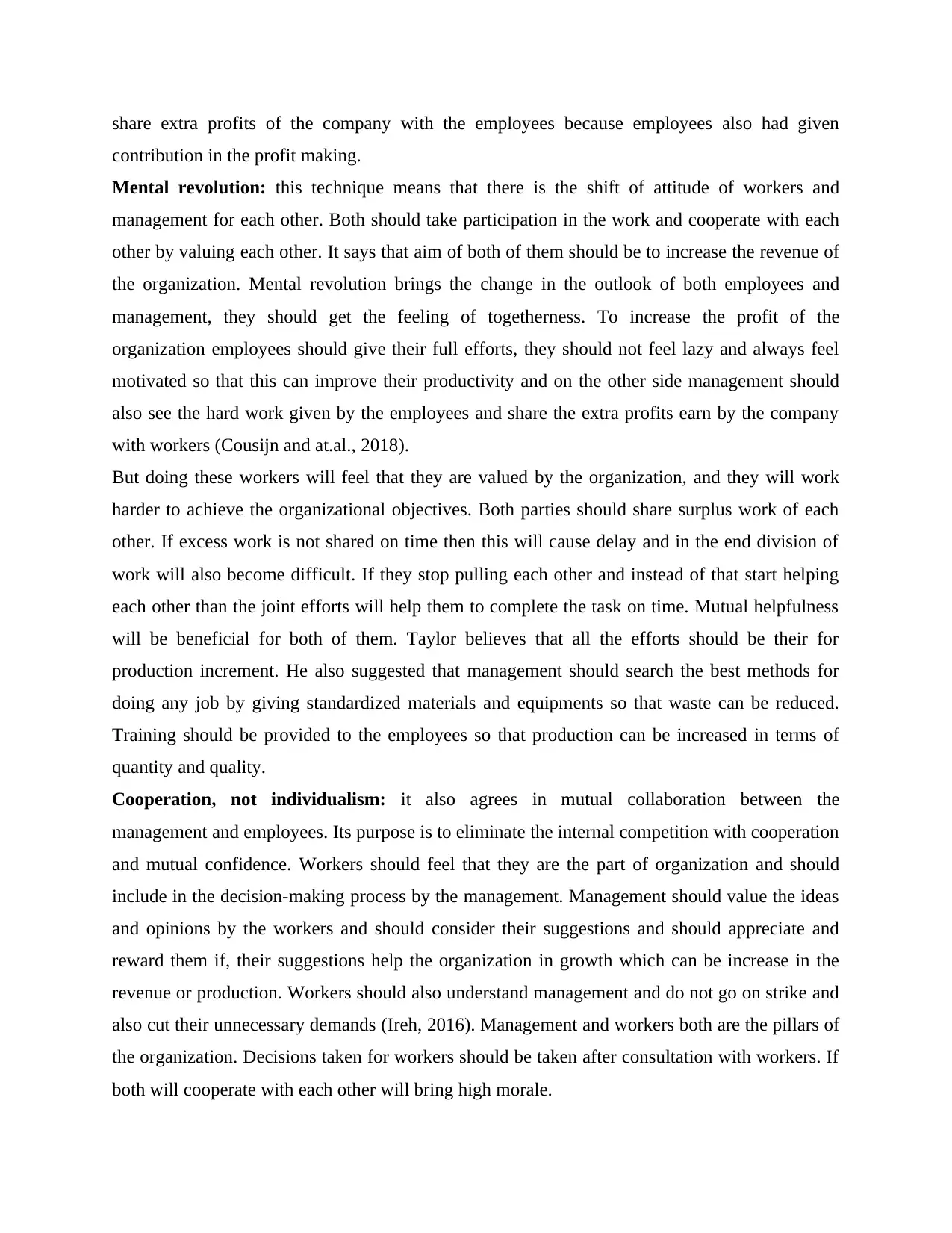
share extra profits of the company with the employees because employees also had given
contribution in the profit making.
Mental revolution: this technique means that there is the shift of attitude of workers and
management for each other. Both should take participation in the work and cooperate with each
other by valuing each other. It says that aim of both of them should be to increase the revenue of
the organization. Mental revolution brings the change in the outlook of both employees and
management, they should get the feeling of togetherness. To increase the profit of the
organization employees should give their full efforts, they should not feel lazy and always feel
motivated so that this can improve their productivity and on the other side management should
also see the hard work given by the employees and share the extra profits earn by the company
with workers (Cousijn and at.al., 2018).
But doing these workers will feel that they are valued by the organization, and they will work
harder to achieve the organizational objectives. Both parties should share surplus work of each
other. If excess work is not shared on time then this will cause delay and in the end division of
work will also become difficult. If they stop pulling each other and instead of that start helping
each other than the joint efforts will help them to complete the task on time. Mutual helpfulness
will be beneficial for both of them. Taylor believes that all the efforts should be their for
production increment. He also suggested that management should search the best methods for
doing any job by giving standardized materials and equipments so that waste can be reduced.
Training should be provided to the employees so that production can be increased in terms of
quantity and quality.
Cooperation, not individualism: it also agrees in mutual collaboration between the
management and employees. Its purpose is to eliminate the internal competition with cooperation
and mutual confidence. Workers should feel that they are the part of organization and should
include in the decision-making process by the management. Management should value the ideas
and opinions by the workers and should consider their suggestions and should appreciate and
reward them if, their suggestions help the organization in growth which can be increase in the
revenue or production. Workers should also understand management and do not go on strike and
also cut their unnecessary demands (Ireh, 2016). Management and workers both are the pillars of
the organization. Decisions taken for workers should be taken after consultation with workers. If
both will cooperate with each other will bring high morale.
contribution in the profit making.
Mental revolution: this technique means that there is the shift of attitude of workers and
management for each other. Both should take participation in the work and cooperate with each
other by valuing each other. It says that aim of both of them should be to increase the revenue of
the organization. Mental revolution brings the change in the outlook of both employees and
management, they should get the feeling of togetherness. To increase the profit of the
organization employees should give their full efforts, they should not feel lazy and always feel
motivated so that this can improve their productivity and on the other side management should
also see the hard work given by the employees and share the extra profits earn by the company
with workers (Cousijn and at.al., 2018).
But doing these workers will feel that they are valued by the organization, and they will work
harder to achieve the organizational objectives. Both parties should share surplus work of each
other. If excess work is not shared on time then this will cause delay and in the end division of
work will also become difficult. If they stop pulling each other and instead of that start helping
each other than the joint efforts will help them to complete the task on time. Mutual helpfulness
will be beneficial for both of them. Taylor believes that all the efforts should be their for
production increment. He also suggested that management should search the best methods for
doing any job by giving standardized materials and equipments so that waste can be reduced.
Training should be provided to the employees so that production can be increased in terms of
quantity and quality.
Cooperation, not individualism: it also agrees in mutual collaboration between the
management and employees. Its purpose is to eliminate the internal competition with cooperation
and mutual confidence. Workers should feel that they are the part of organization and should
include in the decision-making process by the management. Management should value the ideas
and opinions by the workers and should consider their suggestions and should appreciate and
reward them if, their suggestions help the organization in growth which can be increase in the
revenue or production. Workers should also understand management and do not go on strike and
also cut their unnecessary demands (Ireh, 2016). Management and workers both are the pillars of
the organization. Decisions taken for workers should be taken after consultation with workers. If
both will cooperate with each other will bring high morale.
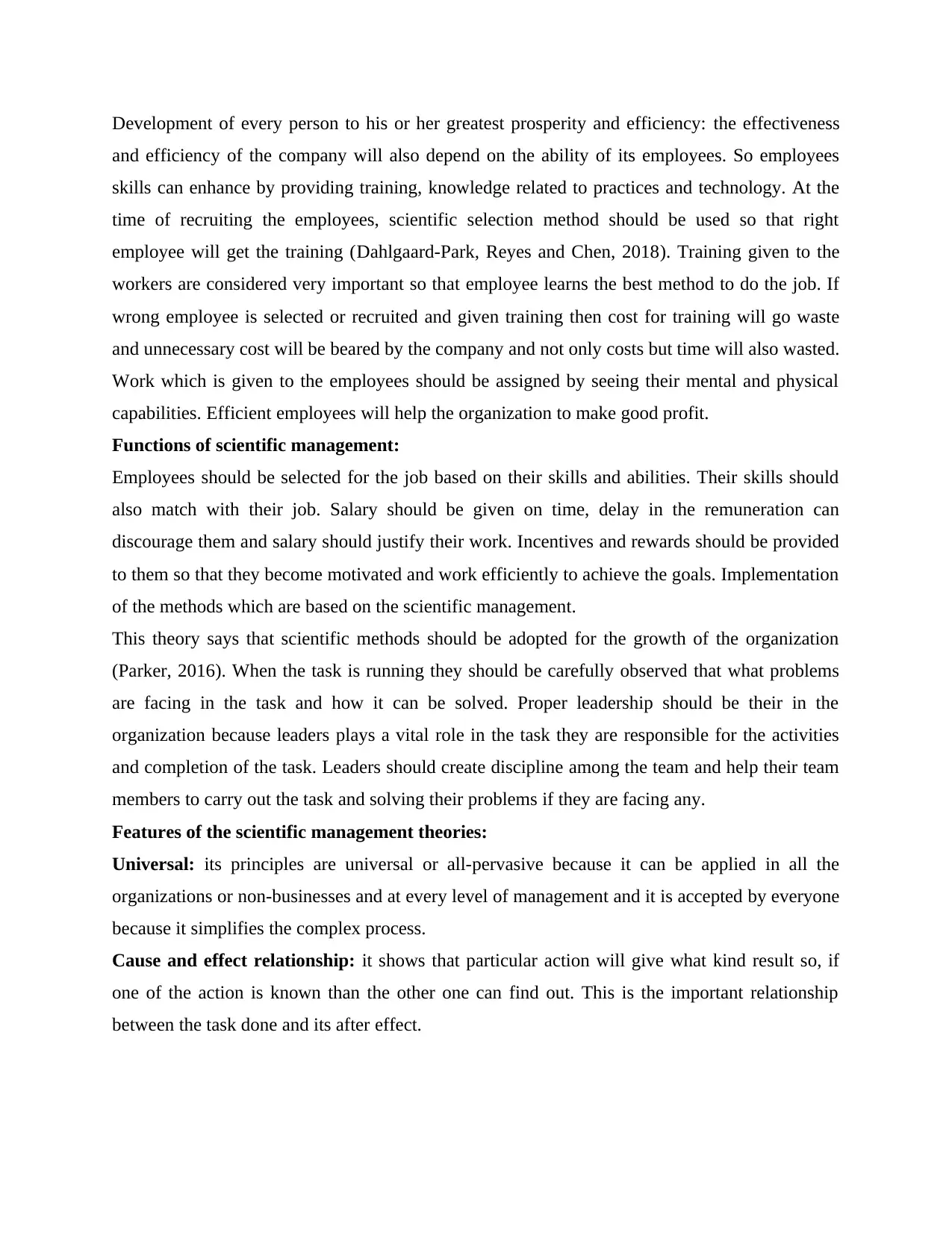
Development of every person to his or her greatest prosperity and efficiency: the effectiveness
and efficiency of the company will also depend on the ability of its employees. So employees
skills can enhance by providing training, knowledge related to practices and technology. At the
time of recruiting the employees, scientific selection method should be used so that right
employee will get the training (Dahlgaard-Park, Reyes and Chen, 2018). Training given to the
workers are considered very important so that employee learns the best method to do the job. If
wrong employee is selected or recruited and given training then cost for training will go waste
and unnecessary cost will be beared by the company and not only costs but time will also wasted.
Work which is given to the employees should be assigned by seeing their mental and physical
capabilities. Efficient employees will help the organization to make good profit.
Functions of scientific management:
Employees should be selected for the job based on their skills and abilities. Their skills should
also match with their job. Salary should be given on time, delay in the remuneration can
discourage them and salary should justify their work. Incentives and rewards should be provided
to them so that they become motivated and work efficiently to achieve the goals. Implementation
of the methods which are based on the scientific management.
This theory says that scientific methods should be adopted for the growth of the organization
(Parker, 2016). When the task is running they should be carefully observed that what problems
are facing in the task and how it can be solved. Proper leadership should be their in the
organization because leaders plays a vital role in the task they are responsible for the activities
and completion of the task. Leaders should create discipline among the team and help their team
members to carry out the task and solving their problems if they are facing any.
Features of the scientific management theories:
Universal: its principles are universal or all-pervasive because it can be applied in all the
organizations or non-businesses and at every level of management and it is accepted by everyone
because it simplifies the complex process.
Cause and effect relationship: it shows that particular action will give what kind result so, if
one of the action is known than the other one can find out. This is the important relationship
between the task done and its after effect.
and efficiency of the company will also depend on the ability of its employees. So employees
skills can enhance by providing training, knowledge related to practices and technology. At the
time of recruiting the employees, scientific selection method should be used so that right
employee will get the training (Dahlgaard-Park, Reyes and Chen, 2018). Training given to the
workers are considered very important so that employee learns the best method to do the job. If
wrong employee is selected or recruited and given training then cost for training will go waste
and unnecessary cost will be beared by the company and not only costs but time will also wasted.
Work which is given to the employees should be assigned by seeing their mental and physical
capabilities. Efficient employees will help the organization to make good profit.
Functions of scientific management:
Employees should be selected for the job based on their skills and abilities. Their skills should
also match with their job. Salary should be given on time, delay in the remuneration can
discourage them and salary should justify their work. Incentives and rewards should be provided
to them so that they become motivated and work efficiently to achieve the goals. Implementation
of the methods which are based on the scientific management.
This theory says that scientific methods should be adopted for the growth of the organization
(Parker, 2016). When the task is running they should be carefully observed that what problems
are facing in the task and how it can be solved. Proper leadership should be their in the
organization because leaders plays a vital role in the task they are responsible for the activities
and completion of the task. Leaders should create discipline among the team and help their team
members to carry out the task and solving their problems if they are facing any.
Features of the scientific management theories:
Universal: its principles are universal or all-pervasive because it can be applied in all the
organizations or non-businesses and at every level of management and it is accepted by everyone
because it simplifies the complex process.
Cause and effect relationship: it shows that particular action will give what kind result so, if
one of the action is known than the other one can find out. This is the important relationship
between the task done and its after effect.
⊘ This is a preview!⊘
Do you want full access?
Subscribe today to unlock all pages.

Trusted by 1+ million students worldwide
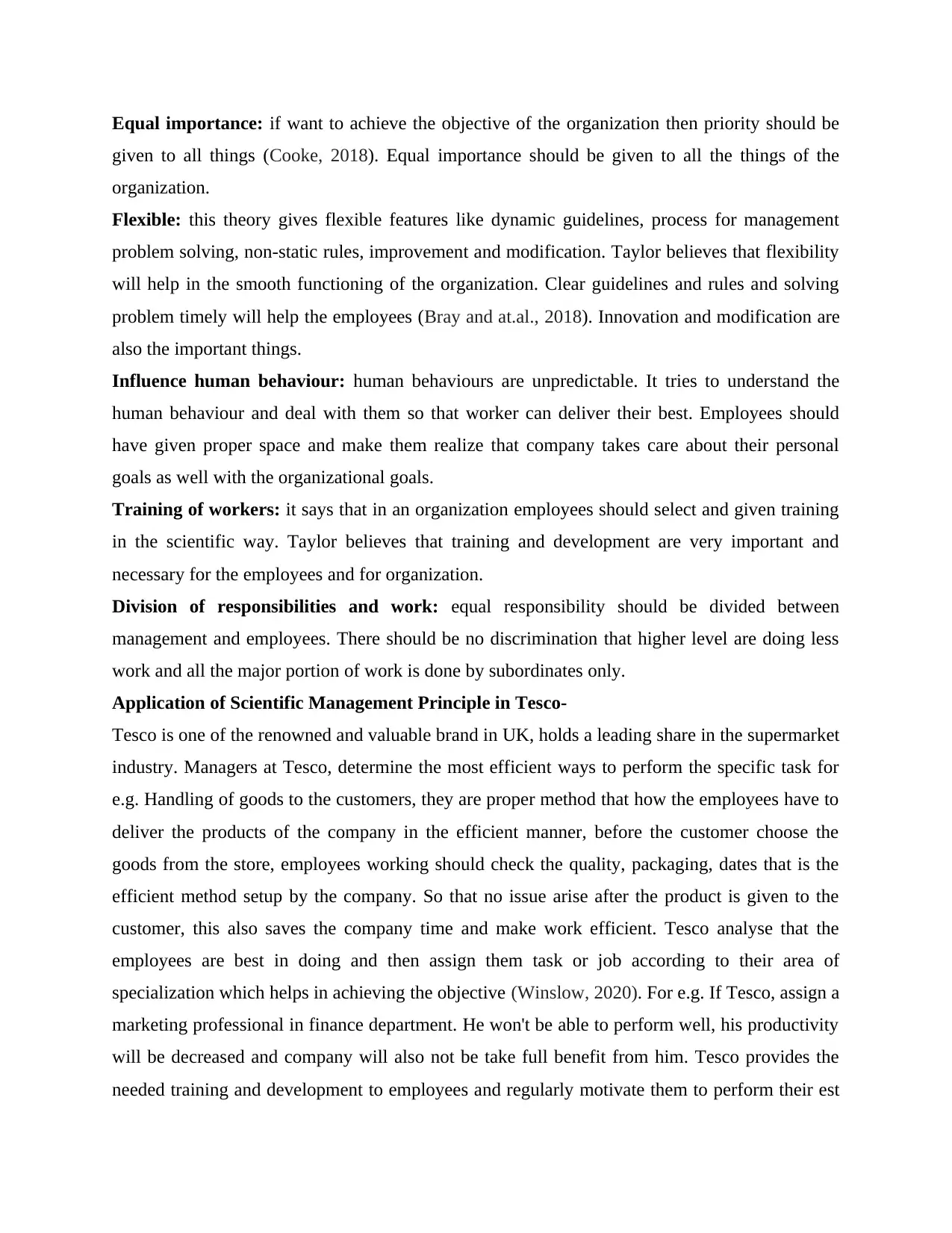
Equal importance: if want to achieve the objective of the organization then priority should be
given to all things (Cooke, 2018). Equal importance should be given to all the things of the
organization.
Flexible: this theory gives flexible features like dynamic guidelines, process for management
problem solving, non-static rules, improvement and modification. Taylor believes that flexibility
will help in the smooth functioning of the organization. Clear guidelines and rules and solving
problem timely will help the employees (Bray and at.al., 2018). Innovation and modification are
also the important things.
Influence human behaviour: human behaviours are unpredictable. It tries to understand the
human behaviour and deal with them so that worker can deliver their best. Employees should
have given proper space and make them realize that company takes care about their personal
goals as well with the organizational goals.
Training of workers: it says that in an organization employees should select and given training
in the scientific way. Taylor believes that training and development are very important and
necessary for the employees and for organization.
Division of responsibilities and work: equal responsibility should be divided between
management and employees. There should be no discrimination that higher level are doing less
work and all the major portion of work is done by subordinates only.
Application of Scientific Management Principle in Tesco-
Tesco is one of the renowned and valuable brand in UK, holds a leading share in the supermarket
industry. Managers at Tesco, determine the most efficient ways to perform the specific task for
e.g. Handling of goods to the customers, they are proper method that how the employees have to
deliver the products of the company in the efficient manner, before the customer choose the
goods from the store, employees working should check the quality, packaging, dates that is the
efficient method setup by the company. So that no issue arise after the product is given to the
customer, this also saves the company time and make work efficient. Tesco analyse that the
employees are best in doing and then assign them task or job according to their area of
specialization which helps in achieving the objective (Winslow, 2020). For e.g. If Tesco, assign a
marketing professional in finance department. He won't be able to perform well, his productivity
will be decreased and company will also not be take full benefit from him. Tesco provides the
needed training and development to employees and regularly motivate them to perform their est
given to all things (Cooke, 2018). Equal importance should be given to all the things of the
organization.
Flexible: this theory gives flexible features like dynamic guidelines, process for management
problem solving, non-static rules, improvement and modification. Taylor believes that flexibility
will help in the smooth functioning of the organization. Clear guidelines and rules and solving
problem timely will help the employees (Bray and at.al., 2018). Innovation and modification are
also the important things.
Influence human behaviour: human behaviours are unpredictable. It tries to understand the
human behaviour and deal with them so that worker can deliver their best. Employees should
have given proper space and make them realize that company takes care about their personal
goals as well with the organizational goals.
Training of workers: it says that in an organization employees should select and given training
in the scientific way. Taylor believes that training and development are very important and
necessary for the employees and for organization.
Division of responsibilities and work: equal responsibility should be divided between
management and employees. There should be no discrimination that higher level are doing less
work and all the major portion of work is done by subordinates only.
Application of Scientific Management Principle in Tesco-
Tesco is one of the renowned and valuable brand in UK, holds a leading share in the supermarket
industry. Managers at Tesco, determine the most efficient ways to perform the specific task for
e.g. Handling of goods to the customers, they are proper method that how the employees have to
deliver the products of the company in the efficient manner, before the customer choose the
goods from the store, employees working should check the quality, packaging, dates that is the
efficient method setup by the company. So that no issue arise after the product is given to the
customer, this also saves the company time and make work efficient. Tesco analyse that the
employees are best in doing and then assign them task or job according to their area of
specialization which helps in achieving the objective (Winslow, 2020). For e.g. If Tesco, assign a
marketing professional in finance department. He won't be able to perform well, his productivity
will be decreased and company will also not be take full benefit from him. Tesco provides the
needed training and development to employees and regularly motivate them to perform their est
Paraphrase This Document
Need a fresh take? Get an instant paraphrase of this document with our AI Paraphraser
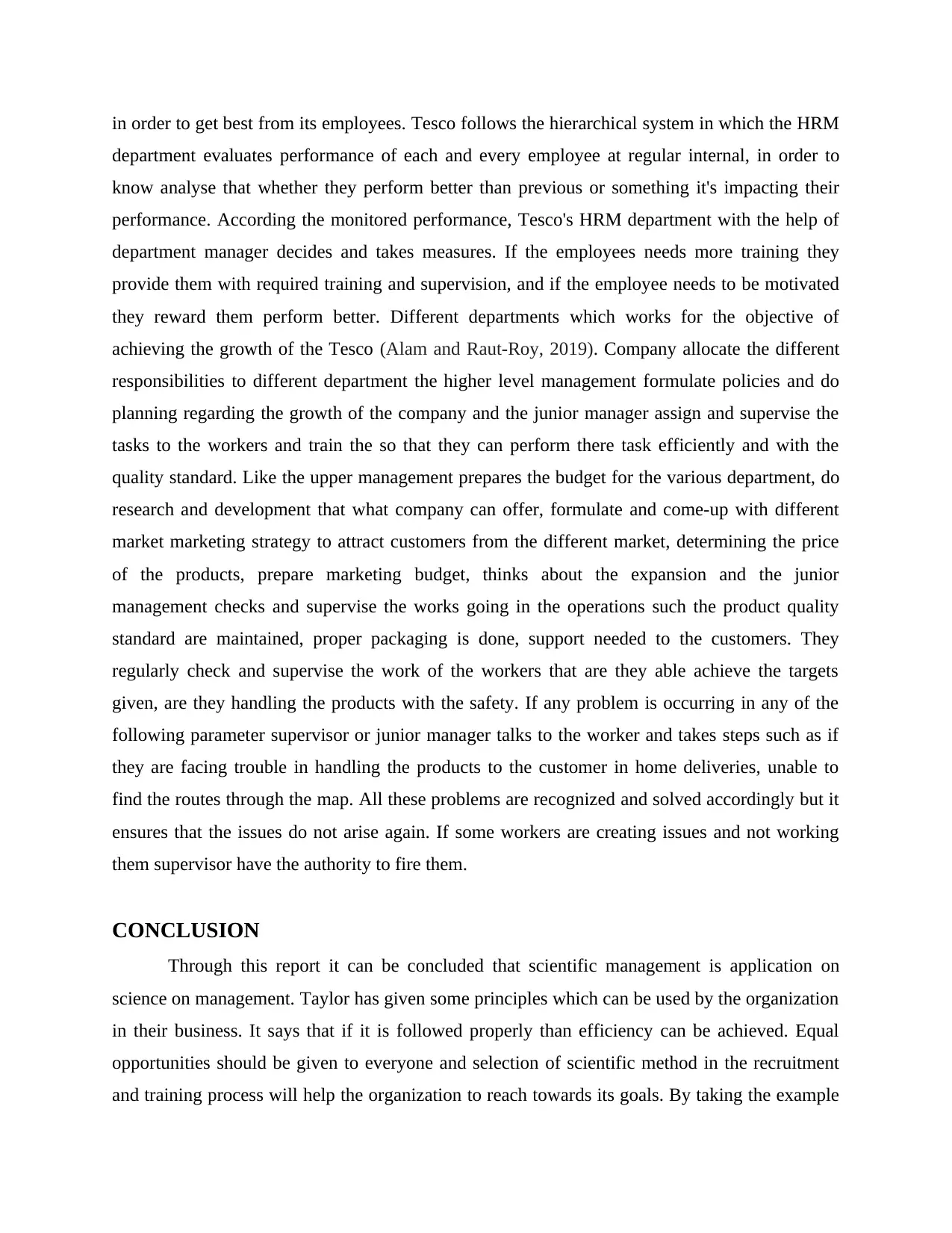
in order to get best from its employees. Tesco follows the hierarchical system in which the HRM
department evaluates performance of each and every employee at regular internal, in order to
know analyse that whether they perform better than previous or something it's impacting their
performance. According the monitored performance, Tesco's HRM department with the help of
department manager decides and takes measures. If the employees needs more training they
provide them with required training and supervision, and if the employee needs to be motivated
they reward them perform better. Different departments which works for the objective of
achieving the growth of the Tesco (Alam and Raut-Roy, 2019). Company allocate the different
responsibilities to different department the higher level management formulate policies and do
planning regarding the growth of the company and the junior manager assign and supervise the
tasks to the workers and train the so that they can perform there task efficiently and with the
quality standard. Like the upper management prepares the budget for the various department, do
research and development that what company can offer, formulate and come-up with different
market marketing strategy to attract customers from the different market, determining the price
of the products, prepare marketing budget, thinks about the expansion and the junior
management checks and supervise the works going in the operations such the product quality
standard are maintained, proper packaging is done, support needed to the customers. They
regularly check and supervise the work of the workers that are they able achieve the targets
given, are they handling the products with the safety. If any problem is occurring in any of the
following parameter supervisor or junior manager talks to the worker and takes steps such as if
they are facing trouble in handling the products to the customer in home deliveries, unable to
find the routes through the map. All these problems are recognized and solved accordingly but it
ensures that the issues do not arise again. If some workers are creating issues and not working
them supervisor have the authority to fire them.
CONCLUSION
Through this report it can be concluded that scientific management is application on
science on management. Taylor has given some principles which can be used by the organization
in their business. It says that if it is followed properly than efficiency can be achieved. Equal
opportunities should be given to everyone and selection of scientific method in the recruitment
and training process will help the organization to reach towards its goals. By taking the example
department evaluates performance of each and every employee at regular internal, in order to
know analyse that whether they perform better than previous or something it's impacting their
performance. According the monitored performance, Tesco's HRM department with the help of
department manager decides and takes measures. If the employees needs more training they
provide them with required training and supervision, and if the employee needs to be motivated
they reward them perform better. Different departments which works for the objective of
achieving the growth of the Tesco (Alam and Raut-Roy, 2019). Company allocate the different
responsibilities to different department the higher level management formulate policies and do
planning regarding the growth of the company and the junior manager assign and supervise the
tasks to the workers and train the so that they can perform there task efficiently and with the
quality standard. Like the upper management prepares the budget for the various department, do
research and development that what company can offer, formulate and come-up with different
market marketing strategy to attract customers from the different market, determining the price
of the products, prepare marketing budget, thinks about the expansion and the junior
management checks and supervise the works going in the operations such the product quality
standard are maintained, proper packaging is done, support needed to the customers. They
regularly check and supervise the work of the workers that are they able achieve the targets
given, are they handling the products with the safety. If any problem is occurring in any of the
following parameter supervisor or junior manager talks to the worker and takes steps such as if
they are facing trouble in handling the products to the customer in home deliveries, unable to
find the routes through the map. All these problems are recognized and solved accordingly but it
ensures that the issues do not arise again. If some workers are creating issues and not working
them supervisor have the authority to fire them.
CONCLUSION
Through this report it can be concluded that scientific management is application on
science on management. Taylor has given some principles which can be used by the organization
in their business. It says that if it is followed properly than efficiency can be achieved. Equal
opportunities should be given to everyone and selection of scientific method in the recruitment
and training process will help the organization to reach towards its goals. By taking the example

of Tesco it is explained that how the company has applied scientific management in their
business.
business.
⊘ This is a preview!⊘
Do you want full access?
Subscribe today to unlock all pages.

Trusted by 1+ million students worldwide
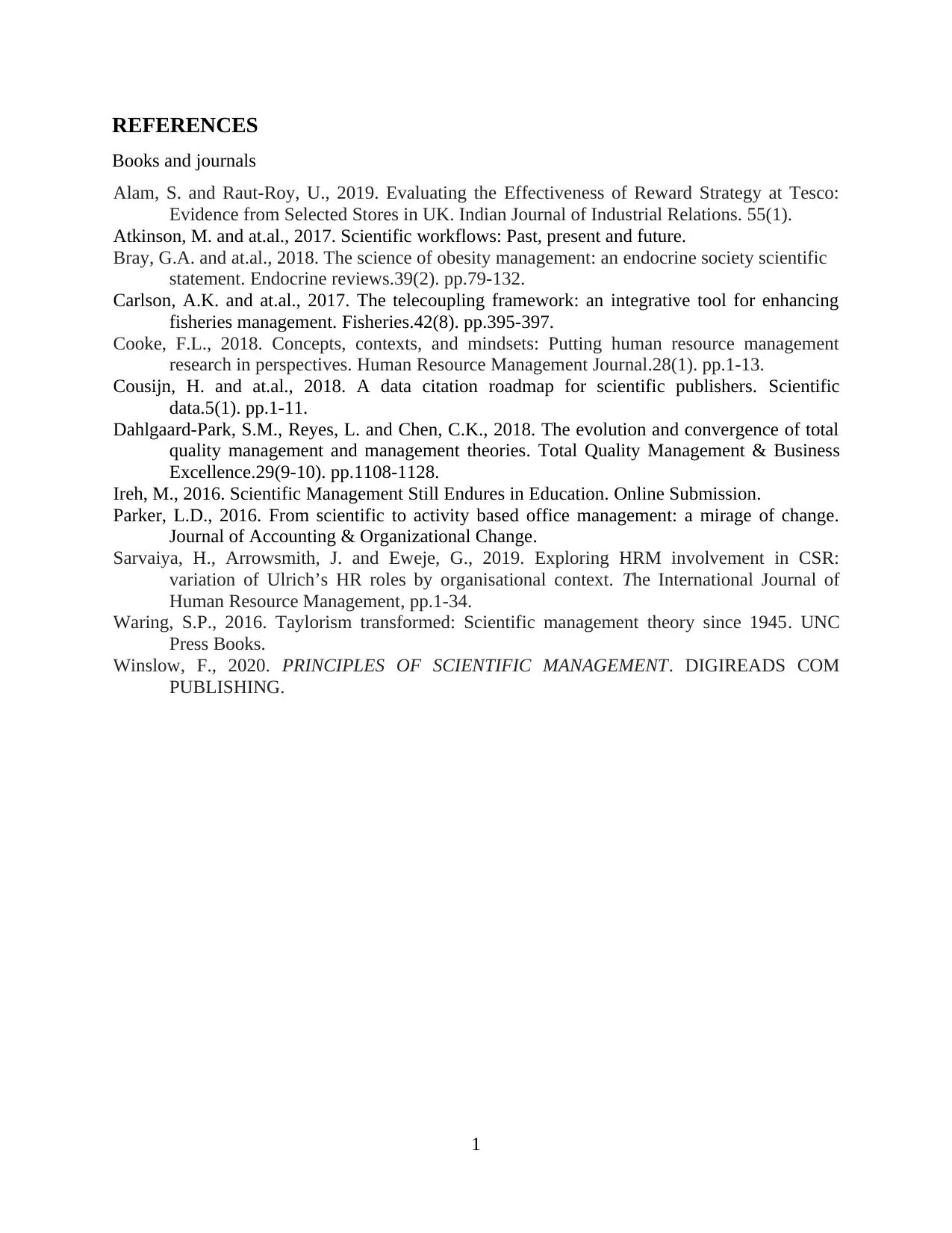
REFERENCES
Books and journals
Alam, S. and Raut-Roy, U., 2019. Evaluating the Effectiveness of Reward Strategy at Tesco:
Evidence from Selected Stores in UK. Indian Journal of Industrial Relations. 55(1).
Atkinson, M. and at.al., 2017. Scientific workflows: Past, present and future.
Bray, G.A. and at.al., 2018. The science of obesity management: an endocrine society scientific
statement. Endocrine reviews.39(2). pp.79-132.
Carlson, A.K. and at.al., 2017. The telecoupling framework: an integrative tool for enhancing
fisheries management. Fisheries.42(8). pp.395-397.
Cooke, F.L., 2018. Concepts, contexts, and mindsets: Putting human resource management
research in perspectives. Human Resource Management Journal.28(1). pp.1-13.
Cousijn, H. and at.al., 2018. A data citation roadmap for scientific publishers. Scientific
data.5(1). pp.1-11.
Dahlgaard-Park, S.M., Reyes, L. and Chen, C.K., 2018. The evolution and convergence of total
quality management and management theories. Total Quality Management & Business
Excellence.29(9-10). pp.1108-1128.
Ireh, M., 2016. Scientific Management Still Endures in Education. Online Submission.
Parker, L.D., 2016. From scientific to activity based office management: a mirage of change.
Journal of Accounting & Organizational Change.
Sarvaiya, H., Arrowsmith, J. and Eweje, G., 2019. Exploring HRM involvement in CSR:
variation of Ulrich’s HR roles by organisational context. The International Journal of
Human Resource Management, pp.1-34.
Waring, S.P., 2016. Taylorism transformed: Scientific management theory since 1945. UNC
Press Books.
Winslow, F., 2020. PRINCIPLES OF SCIENTIFIC MANAGEMENT. DIGIREADS COM
PUBLISHING.
1
Books and journals
Alam, S. and Raut-Roy, U., 2019. Evaluating the Effectiveness of Reward Strategy at Tesco:
Evidence from Selected Stores in UK. Indian Journal of Industrial Relations. 55(1).
Atkinson, M. and at.al., 2017. Scientific workflows: Past, present and future.
Bray, G.A. and at.al., 2018. The science of obesity management: an endocrine society scientific
statement. Endocrine reviews.39(2). pp.79-132.
Carlson, A.K. and at.al., 2017. The telecoupling framework: an integrative tool for enhancing
fisheries management. Fisheries.42(8). pp.395-397.
Cooke, F.L., 2018. Concepts, contexts, and mindsets: Putting human resource management
research in perspectives. Human Resource Management Journal.28(1). pp.1-13.
Cousijn, H. and at.al., 2018. A data citation roadmap for scientific publishers. Scientific
data.5(1). pp.1-11.
Dahlgaard-Park, S.M., Reyes, L. and Chen, C.K., 2018. The evolution and convergence of total
quality management and management theories. Total Quality Management & Business
Excellence.29(9-10). pp.1108-1128.
Ireh, M., 2016. Scientific Management Still Endures in Education. Online Submission.
Parker, L.D., 2016. From scientific to activity based office management: a mirage of change.
Journal of Accounting & Organizational Change.
Sarvaiya, H., Arrowsmith, J. and Eweje, G., 2019. Exploring HRM involvement in CSR:
variation of Ulrich’s HR roles by organisational context. The International Journal of
Human Resource Management, pp.1-34.
Waring, S.P., 2016. Taylorism transformed: Scientific management theory since 1945. UNC
Press Books.
Winslow, F., 2020. PRINCIPLES OF SCIENTIFIC MANAGEMENT. DIGIREADS COM
PUBLISHING.
1
1 out of 10
Related Documents
Your All-in-One AI-Powered Toolkit for Academic Success.
+13062052269
info@desklib.com
Available 24*7 on WhatsApp / Email
![[object Object]](/_next/static/media/star-bottom.7253800d.svg)
Unlock your academic potential
© 2024 | Zucol Services PVT LTD | All rights reserved.





